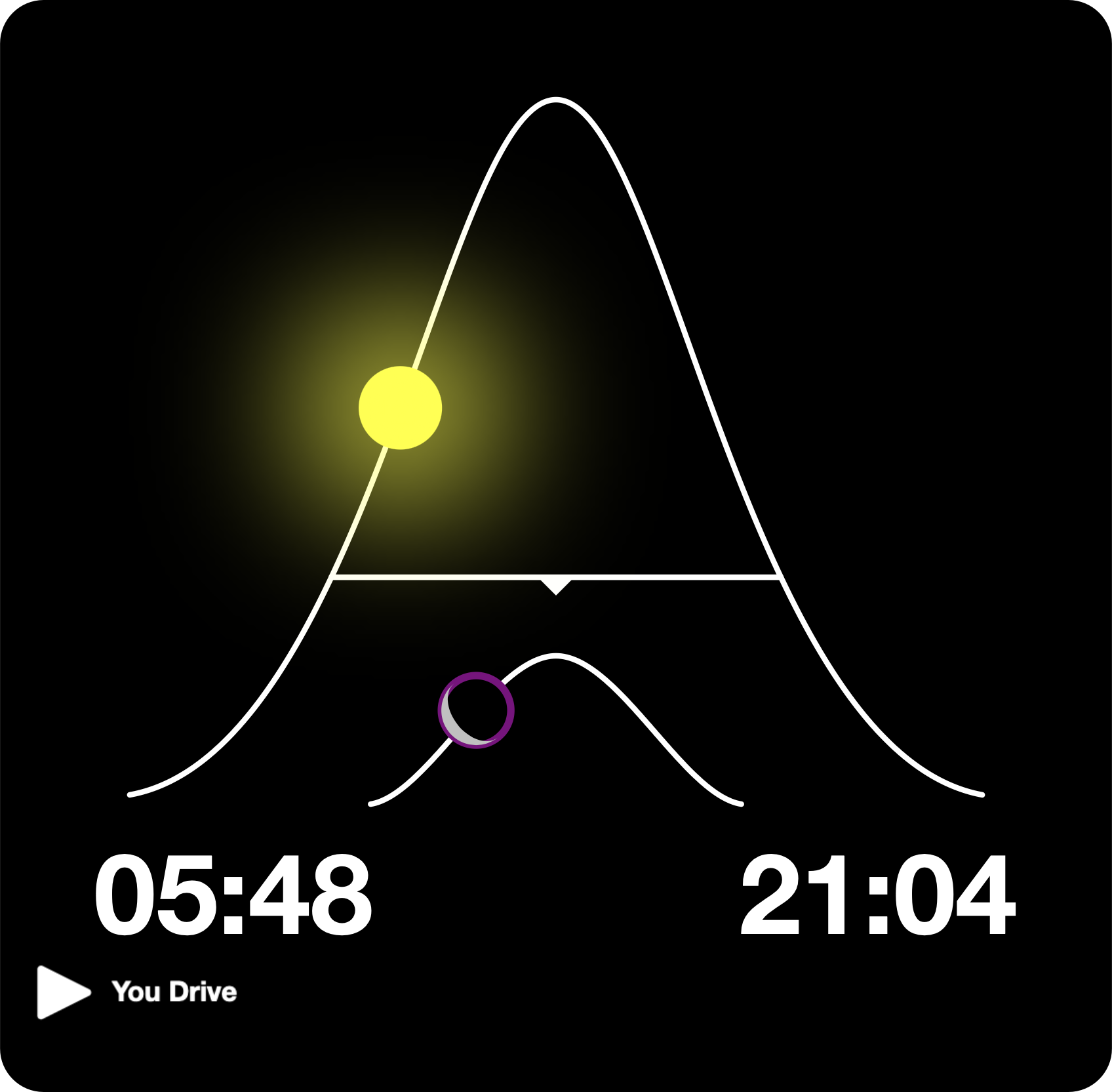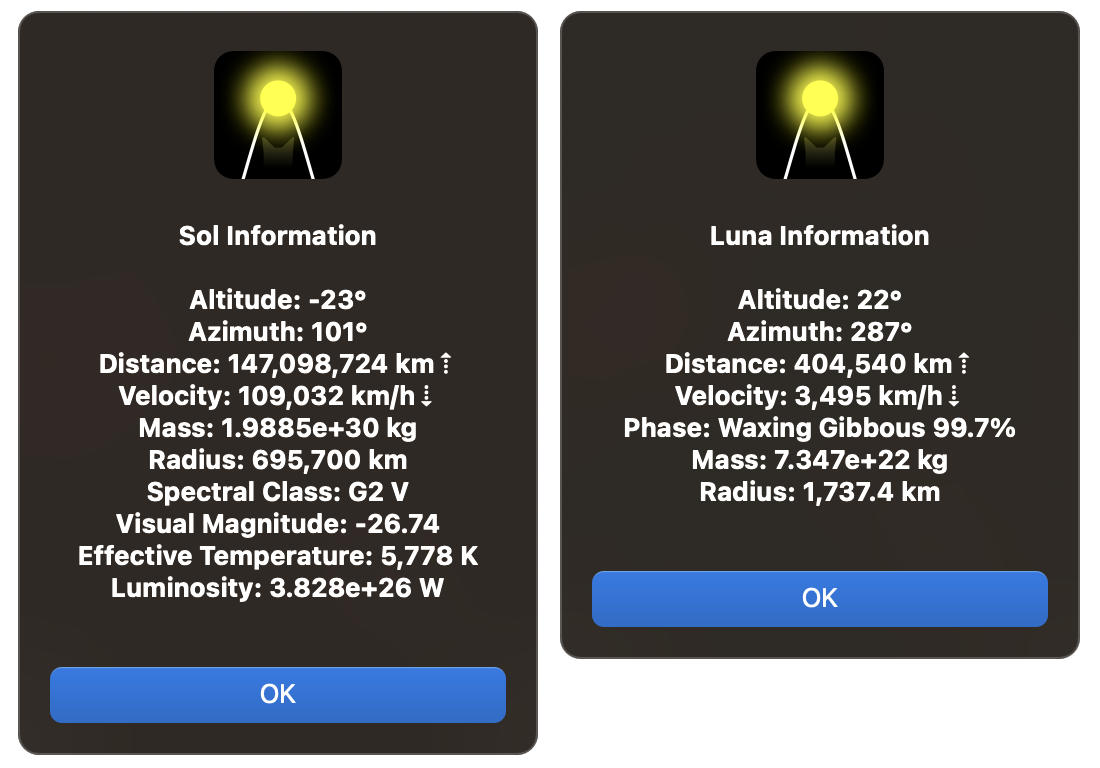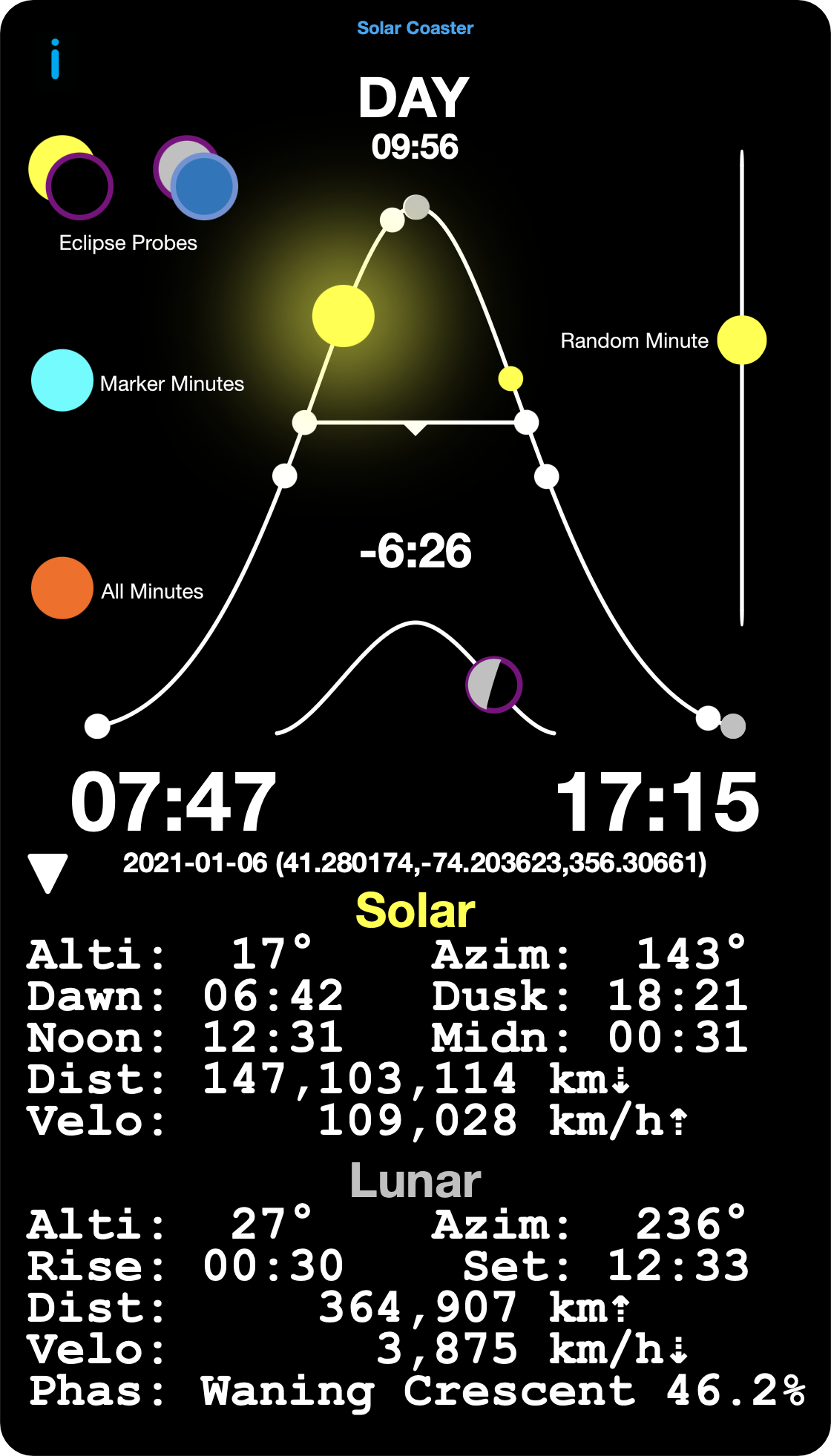Solar Coaster visualizes the rise and set of Earth's nearest star, Sol, our Sun, and probes for upcoming solar and lunar eclipses. The App uses what astronomers call a local horizon coordinate system when displaying information, which essentially means that your current position is the center of the Universe and all calculated values are relative to you. The simulator is available in three distinct flavors: an App for iOS and macOS, a Today Extension for iOS and a Screen Saver for macOS.
Topics
Overview
Solar Coaster stores enough onboard astronomical data to keep it running through the year 2100 AD, which means that all orbital calculations can be performed locally without the need of a network connection. Algorithms are accurate at all longitudes, and latitudes between -81° south and +82° north. Of course, you must have Location Services enabled1 and allow Solar Coaster to access your position for accurate simulation results, and to properly detect eclipses visible at your location. You can also allow Notification Center to keep you informed on when those eclipses will occur.

A sinusoidal curve depicts Sol's path for a single day, Today. An artificial, horizontal, horizon line is drawn such that it intersects the curve at precisely two points, Sunrise and Sunset. This means that all points on the curve above the horizon line are Day, and those below are Night. As the lengths of Day and Night change this horizon line shifts up and down the sinusoidal curve, and a trend direction triangle indicates how the shift is moving. The actual Sunrise and Sunset times are also displayed, in 12 or 24-hour format.
The point exactly midway along the Day portion of the sinusoidal curve is called Solar Noon, and represents the time of day Sol is farthest above the horizon. Solar Noon typically does not coincide with 12 o'clock Noon.
The point exactly midway along the Night portion of the sinusoidal curve is called Solar Midnight, and represents the time of day Sol is farthest below the horizon. Solar Midnight typically does not coincide with 12 o'clock Midnight.
Dawn precedes Sunrise, and Dusk succeeds Sunset. During these times of Morning Twilight and Evening Twilight Sol slowly brightens and dims appropriately.
Earth's nearest celestial neighbor, Luna, our Moon, sometimes makes appearances during the visualization. At Moonrise a smaller, secondary, sinusoidal curve appears and Luna fades-in. Luna is drawn with its proper phase, and rotated to the precise phase angle. At Moonset Luna fades-out.
Touching either Sol or Luna displays a tiny bit of additional realtime information (unavailable for the Today Extension and Screen Saver). Distance and velocity are suffixed with a trend arrow indicating
how the value is changing over time.

Solar Coaster has various settings, help and auxiliary information:
- For the iOS App use i and Settings / Solar Coaster.
- For the macOS App use its Help and Solar Coaster menus.
- For the macOS Screen Saver use System Settings / Screen Saver / Options.
1. [ When Solar Coaster first runs, iOS and macOS ask for permission to access your current location with this note: "Your location is required for solar and lunar orbital calculations, and eclipse predictions". If you decline this request a default location of the Royal Observatory, Greenwich, England is used. To subsequently enable Location Services: - For iOS touch Settings / Privacy & Security / Location Services, ensure the service is on, then scroll down to Solar Coaster and enable While Using the App.
- For macOS click System Settings / Privacy & Security / Location Services, ensure the service is on, then check all of Solar Coaster and legacyScreenSaver.
]↩
Topics
You Drive Mode
Once a minute orbital calculations are performed and the visualization is updated. This means that if you are patient, very, very patient, you can watch Sol and Luna move! For those not so patient, touch the disclosure triangle and switch into manual You Drive mode (unavailable for the Today Extension and Screen Saver). The simulation is paused and the scene is augmented with informative data, various small, circular, marker points, three larger, colored, touch discs, Solar and Lunar Eclipse Probe controls, and a timer, which begins at +0:00, Now.

In You Drive mode:
- The white circular markers represent the cardinal times of the day: Solar Midnight, Dawn, Sunrise, Noon, Solar Noon, Sunset, Dusk and Midnight. The yellow marker is Now. The silver markers indicate Moonrise and Moonset, assuming there is a rise and/or set for Today. Touching a marker displays its time (unavailable for the Today Extension and Screen Saver).
- Touching the horizon line's trend direction triangle displays the amount of daylight.
- Touching the cyan disc animates the simulation through the special marker times, and those times only. Touch again to stop.
- Touching the orange disc animates the simulation through the entire day of 1,440 minutes. Touch again to stop.
- Touching and sliding the yellow disc animates the simulation to a random minute of the day.
- Touching an Eclipse Probe control initiates a search for upcoming solar or lunar eclipses, and if one is visible from your location the You Drive simulator is temporarily reset to that date and the eclipse circumstances are displayed.
The timer shows the elapsed time in hours and minutes of the simulation, whether positive or negative, relative to Now.
Touch the disclosure triangle once again to exit You Drive mode and resume the actual simulation. Don't be surprised if you notice the visualization catch up for lost time. And depending on what the time differential is and whether the simulation time is before or after Now, the tweening may be fast or slow or forward or reverse.
Topics
Installation
- The Solar Coaster Apps for iOS and macOS are available from their respective App Store and install in the standard manner.
- The iOS Today Extension is bundled with its App and becomes available after the App has been installed. To install the extension:
- activate Notification Center by swiping right from the Home screen as needed to reach the first page, then, at the bottom of the screen, touch Edit. Now you can add and/or subtract Today Extensions.
- The macOS Screen Saver is bundled with its App and becomes available after the App has been installed. To install the saver, which has been digitally signed by BigCatOS and notarized by Apple for your security:
- use the App's File / Export Screen Saver menu item to save the zipped Screen Saver.
- or use Safari and download https://www.bigcatos.com/Software/SolarCoasterSS.zip from BigCatOS.
In either case double-click the resulting zipped Screen Saver package to unzip it, which creates the module Solar Coaster.saver. Double click the saver module to finish the install and select it from System Settings / Screen Saver.
Be sure to enable Location Services1, described in the Overview section.
Topics
Acknowledgment
And that's Solar Coaster. Enjoy. Any similarity to the Apple Watch Face Solar is, indeed, intentional.
Topics
What's New?
4.0 - 2023.01.06
- Add instantaneous orbital velocity based on current distance.
- Add current moon phase name and illumination percentage.
- User interface and documentation improvements.
- Miscellanenous bug fixes.
- Minimum iOS version is 11.0 and minimum macOS version is 10.15.
- Update for iOS 16.2 and macOS 13.1.
3.6 - 2022.08.18
- Improve Solar Coaster behavior in low memory conditions.
- Minor bug fixes and improvements.
- Minimum iOS version is 10.0 and minimum macOS version is 10.15.
- Update for iOS 15.6 and macOS 12.5.
3.5 - 2022.04.01
- Fix, finally, the jarring "white flash" at startup for the macOS App and Screen Saver.
- The iOS and macOS Apps can, with your permission, post summary eclipse data to the Notification Center. This means you can badge the App's icon with an eclipse count, or list the eclipses in Notification Center, or both. Or neither, controllable in iOS Settings and macOS System Preferences.
- The eclipse summary is refreshed automatically once daily.
- The Refine Position Every Minute Preference has now been implemented in the macOS App and Screen Saver.
- The Location Override Preference has now been implemented in the macOS Screen Saver.
- Although the macOS Screen Saver cannot post an eclipse summary in Notification Center, it does show the summary in Screen Saver Options..., under the new tab Eclipses.
- The macOS App can now export its matching Screen Saver with the new Export Screen Saver menu item.
- Minimum iOS version is 10.0 and minimum macOS version is 10.14.
- Minor bug fixes and improvements.
- Update for iOS 15.4 and macOS 12.3.
3.4 - 2022.02.11
- For iOS only, add a new Setting named Refine Position Every Minute. By default your location is determined once, at startup. But when chasing an eclipse it has proven convenient to update the device's position on-the-fly to keep calculations as accurate as possible.
- Minor bug fixes and improvements.
- Update for iOS 15.3, macOS 12.2.
3.3 - 2021.05.17
- Tween bug fix: sometimes the animation would stop at solar midnight.
- Protect against NaN while computing Luna's orbital path.
- New macOS Universal binary that runs on either Apple Silicon or Intel Macs.
- Update for iOS 14.5.1 and macOS 11.3.1.
3.2 - 2020.07.25
- Protect against NaN while computing Sol's orbital path.
- Fix display update issue after returning from the background.
- Update for iOS 13.6 and macOS 10.15.6.
3.1 - 2020.06.02
- New dynamic background theme OS Appearance that switches between themes Day and Night depending upon the operating system light / dark appearance.
If the operating system doesn't support appearances then the old-style light appearance is used.
- Conform with Apple's 2020.06.30 App Store guidelines.
- Update for iOS 13.5.1 and macOS 10.15.5.
3.0 - 2020.02.29
- Location information now includes the Z-coordinate, altitude, for more refined time calculations.
- If location services are inaccurate or unavailable, the iOS and macOS Apps allow you to manually specify the simulator's latitude, longitude and altitude.
- Orbital calculations are now accurate through 2100 AD.
- Minor bug fixes.
- Update for iOS 13.3.1 and macOS 10.15.3.
2.1 - 2019.03.21
- Lunar eclipse bug fix.
- Update for macOS 10.14.3 and iOS 12.1.4.
- Documentation now supports BigCatOS Appearances.
2.0 - 2018.11.02
- In addition to the existing Solar Eclipse Probe, there is a new Lunar Eclipse Probe. Get ready for the next Lunar eclipse in your area!
- All orbital calculations are done on-device, network connectivity is no longer required.
- Extensive documentation and information display changes.
- Update for macOS 10.14.1 Mojave and iOS 12.
- Even a bug fix or so.
1.3 - 2017.06.08
- Add Solar Eclipse Explorer.
1.0 - 2017.01.02
Topics
Copyright (©) 2017 - 2023 BigCatOS. All rights reserved. | Contact
![]()
![]()


